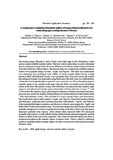| dc.description.abstract | Harvesting mango (Mangifera indica) fruits at the right stage for the destination market and use requires reliable maturity indices. There are various indices that are used to determine harvest maturity for mango fruits. However, differences in cultivars and growing environment affect the reliability of these indices. The present study was conducted to establish maturity indices of two popular mango varieties, ‘Apple’ and ‘Ngowe’. The study was conducted in two contrasting agro-ecological zones (AEZs) of Kenya namely Embu County (a high potential AEZ) and Makueni County (a low potential
AEZ). For each variety , the earliest physiological maturity was determined using flesh color. The flesh color was established by cutting the fruits longitudinally to expose the cross sectional view. The earliest physiological maturity (stage 1) was marked as the stage when the flesh was mostly cream and turning yellow at the seed. The number of days after full bloom was matched to this maturity stage (stage 1) and subsequent maturity stages determined at 10-day intervals as stages 2, 3 and 4. For each of the maturity stages, physiological (ethylene evolution and respiration rates); physical (size, peel/flesh firmness and peel/flesh color) and biochemical (Total soluble solids - TSS, Total titratable acidity – TT A and TSS:TT A ratio) maturity indices were determined.The results show that in both varieties (‘Apple’ and ‘Ngowe’) from both locations (Embu and Makueni), respiration rates increased gradually with maturity . ‘Ngowe’ and Makueni fruits registered the higher respiration and ethylene evolution rates compared to ‘Apple’ and Embu fruits for the same maturity stage.
As maturation progressed, peel firmness decreased gradually irrespective of variety or production location. In all fruits, flesh color (hue angle) decreased gradually with maturity. Total soluble solids increased while TT A decreased
gradually with maturity. Overall, in both varieties, Makueni fruits attained comparable maturity indices to Embu fruits at an earlier stage/date. The results revealed the significant effect of production location on the maturity indices of mango fruits. There is need for additional studies to establish reliable maturity indices for other commercial varieties produced under
different AEZs. | en_US |

